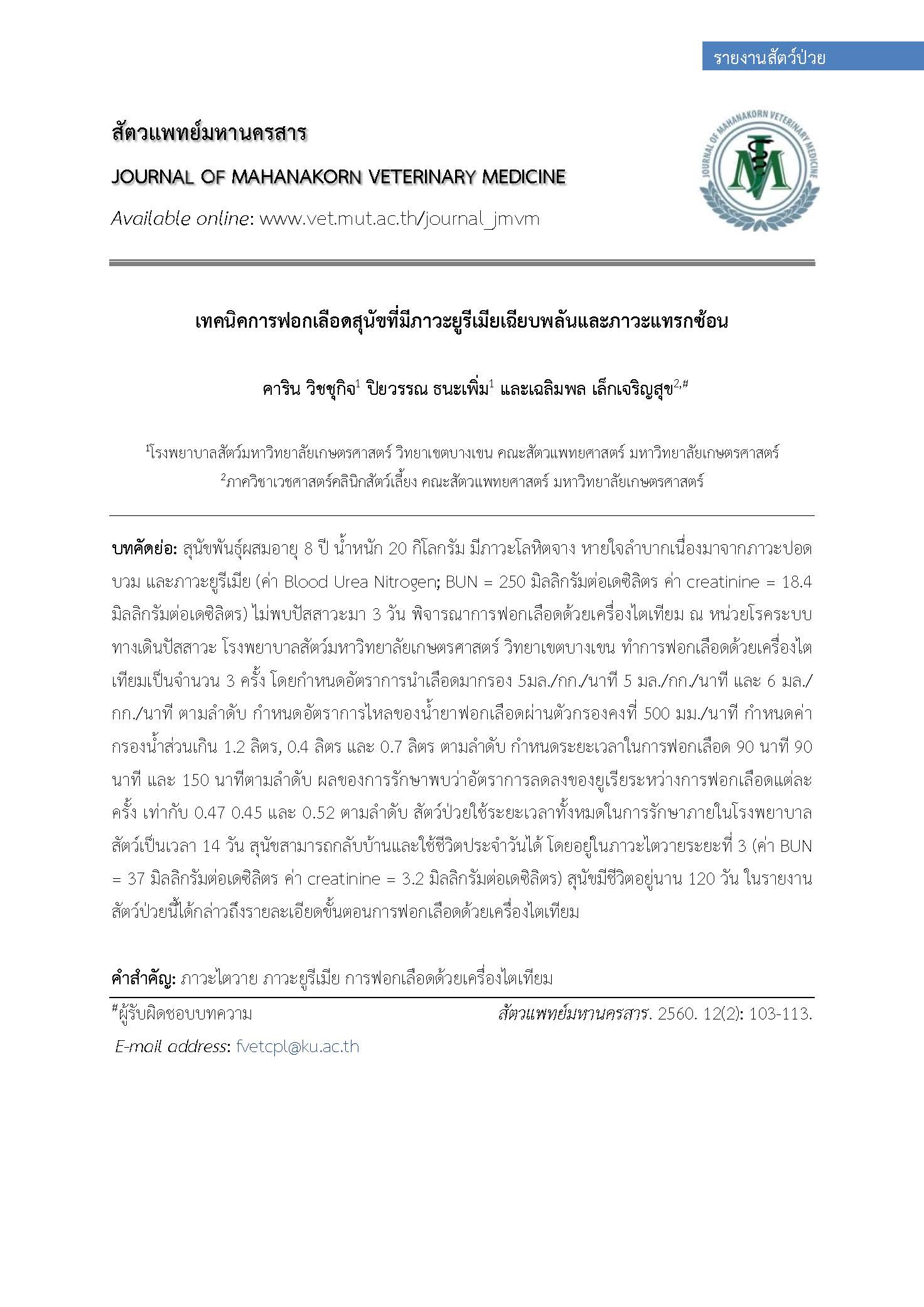Technique of Hemodialysis in Acute Uremia Dog with Complications
Main Article Content
Abstract
An 8 year-old, 20 kg, mixed breed dog presented with anemic condition, respiratory distress condition and severe uremia (BUN = 250 mg/dL, creatinine = 18.4 mg/dL) including anuria for 3 days. Hemodialysis treatments were performed 3 times at Hemodialysis unit, Kasetsart University Veterinary Teaching Hospital (KUVTH). The dialysis machine setting values including blood flow rate was set at 5 ml/kg/min, 5 ml/kg/min and 6 ml/kg/min, respectively. The dialysate flow rate was set at 500 ml/min in every session. The time was set at 90 minutes, 90 minutes and 150 minutes in each session, respectively. The urea reduction ratios were 0.48, 0.45 and 0.52, respectively. At the end of the treatment, the patient’s azotemia level was on stage III of chronic renal disease (BUN = 37 mg/dL, creatinine = 3.17 mg/dL) with normal clinical signs. The time of hospital stay was 14 days. The patient could spend her life almost normally at home and lived 120 days. This case report had described details in the procedure of hemodialysis.
Article Details
References
Cowgill, L.D. 2011. Urea Kinetics and Intermittent Dialysis Prescription in Small Animals. Vet Clin North Am Small Anim Pract. 41(1): 193-225.
Cowgill, L.D. and T. Francey. 2012. Hemodialysis and Extracorporeal Blood Purification, p 680-713. In S. P. Dibartola, eds. Fluid, Electrolyte, and Acid-Base Disorders in Small Animal Practice. Elsevier Saunders.
Donahue, S.M. and C.M. Otto. 2005. Thromboelastography: A Tool for Measuring Hypercoagulability, Hypocoagulability, and Fibrinolysis. J Vet Emerg Crit Care. 15(1): 9-16.
Eatroff, A.E., C.E. Langston, S. Chalhoub, K. Poeppel and E. Mitelberg. 2012. Long-Term Outcome of Cats and Dogs with Acute Kidney Injury Treated with Intermittent Hemodialysis: 135 Cases (1997-2010). J Am Vet Med Assoc. 241(11): 1471-1478.
Elliott, D.A. 2000. Hemodialysis. Clin Tech Small Anim Pract. 15(3): 136-148.
International Renal Interest Society. 2016. (cited 6 September). IRIS annual broad meeting 2016. Available from: http://www.iris-kidney.com/pdf/staging-of-ckd.pdf#page=6
John, Z.M., M.K. George and B.G. Lucien. 1968. Renal Failure and Infection. Medicine. 47(1): 1-32.
Khalid, A. and L. Zafar. 2015. Effect of Haemodialysis on Mean Prothrombin Time and Activated Partial Thromboplastin Time in Patients of End Stage Renal Disease. J Rawal Med Coll (JRMC). 19(3): 247-249.
Mylonakis, M.E., A.F. Koutinas, E.B. Breitschwerdt, B.C. Hegarty, C.D. Billinis, L.S. Leontides and V.S. Kontos. 2004. Chronic Canine Ehrlichiosis (Ehrlichia Canis): A Retrospective Study of 19 Natural Cases. J Am Anim Hosp Assoc. 40(3): 174-184.
Ronco, C. and W. Clark. 2001. Factors Affecting Hemodialysis and Peritoneal Dialysis Efficiency. Semin Dial. 14(4): 257-262.
Seldinger, S.I. 1953. Catheter Replacement of the Needle in Percutaneous Arteriography: a New Technique. Acta radiol. 39(5): 368-376.
Sykes, J.E., K. Hartmann, K.F. Lunn, G.E. Moore, R.A. Stoddard and R.E. Goldstein. 2011. 2010 ACVIM Small Animal Consensus Statement on Leptospirosis: Diagnosis, Epidemiology, Treatment, and Prevention. J Vet Intern Med. 25(1): 1-13.
Tuchman, S., Z.P. Khademian and K. Mistry. 2013. Dialysis Disequilibrium Syndrome Occurring During Continuous Renal Replacement Therapy. Clin Kidney J. 6(5): 526-529.
Vaden, S.L., J. Levine and E.B. Breitschwerdt. 1997. A Retrospective Case-Control of Acute Renal Failure in 99 Dogs. J Vet Intern Med. 11(2): 58-64.


